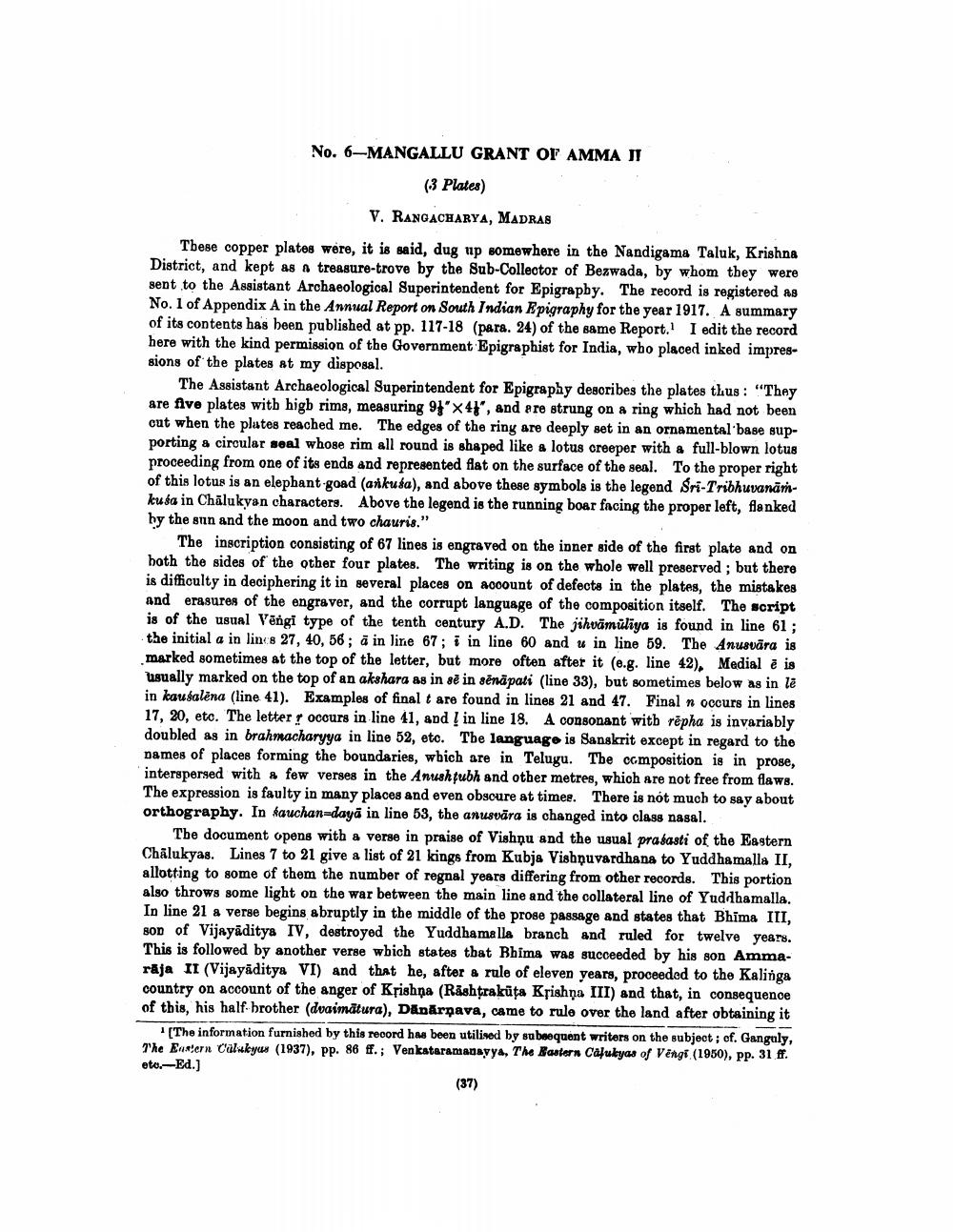________________
No. 6-MANGALLU GRANT OF AMMA II
(3 Plates)
V. RANGACHARYA, MADRAS
These copper plates were, it is said, dug up somewhere in the Nandigama Taluk, Krishna District, and kept as a treasure-trove by the Sub-Collector of Bezwada, by whom they were sent to the Assistant Archaeological Superintendent for Epigraphy. The record is registered as No. 1 of Appendix A in the Annual Report on South Indian Epigraphy for the year 1917. A summary of its contents has been published at pp. 117-18 (para. 24) of the same Report. I edit the record here with the kind permission of the Government Epigraphist for India, who placed inked impressions of the plates at my disposal.
The Assistant Archaeological Superintendent for Epigraphy describes the plates thus: "They are five plates with high rims, measuring 93"x4", and are strung on a ring which had not been cut when the plates reached me. The edges of the ring are deeply set in an ornamental base supporting a circular seal whose rim all round is shaped like a lotus creeper with a full-blown lotus proceeding from one of its ends and represented flat on the surface of the seal. To the proper right of this lotus is an elephant goad (ankusa), and above these symbols is the legend Sri-Tribhuvanāmkusa in Chalukyan characters. Above the legend is the running boar facing the proper left, flanked by the sun and the moon and two chauris."
The inscription consisting of 67 lines is engraved on the inner side of the first plate and on both the sides of the other four plates. The writing is on the whole well preserved; but there is difficulty in deciphering it in several places on account of defects in the plates, the mistakes and erasures of the engraver, and the corrupt language of the composition itself. The script is of the usual Vengi type of the tenth century A.D. The jihvämüliya is found in line 61; the initial a in lines 27, 40, 56; a in line 67; in line 60 and u in line 59. The Anusvara is marked sometimes at the top of the letter, but more often after it (e.g. line 42), Medial è is usually marked on the top of an akshara as in se in senapati (line 33), but sometimes below as in le in kausaléna (line 41). Examples of final t are found in lines 21 and 47. Final n occurs in lines 17, 20, etc. The letter r occurs in line 41, and in line 18. A consonant with repha is invariably doubled as in brahmacharyya in line 52, etc. The language is Sanskrit except in regard to the names of places forming the boundaries, which are in Telugu. The composition is in prose, interspersed with a few verses in the Anushtubh and other metres, which are not free from flaws. The expression is faulty in many places and even obscure at times. There is not much to say about orthography. In fauchan-daya in line 53, the anusvära is changed into class nasal.
The document opens with a verse in praise of Vishnu and the usual prasasti of the Eastern Chalukyas. Lines 7 to 21 give a list of 21 kings from Kubja Vishnuvardhana to Yuddhamalla II, allotting to some of them the number of regnal years differing from other records. This portion also throws some light on the war between the main line and the collateral line of Yuddhamalla. In line 21 a verse begins abruptly in the middle of the prose passage and states that Bhima III, son of Vijayaditya IV, destroyed the Yuddhamalla branch and ruled for twelve years. This is followed by another verse which states that Bhima was succeeded by his son Ammaraja II (Vijayaditya VI) and that he, after a rule of eleven years, proceeded to the Kalinga country on account of the anger of Krishna (Rashtrakuta Krishna III) and that, in consequence of this, his half-brother (dvaimatura), Dänārņava, came to rule over the land after obtaining it
[The information furnished by this record has been utilised by subsequent writers on the subject; cf. Ganguly, The Eastern Calukyas (1937), pp. 86 ff.; Venkataramanayya, The Eastern Calukyas of Vengi (1950), pp. 31 ff. etc.-Ed.]
(37)




